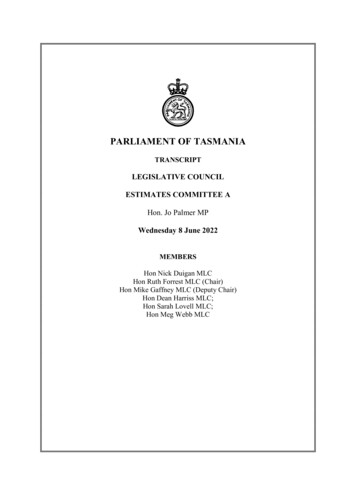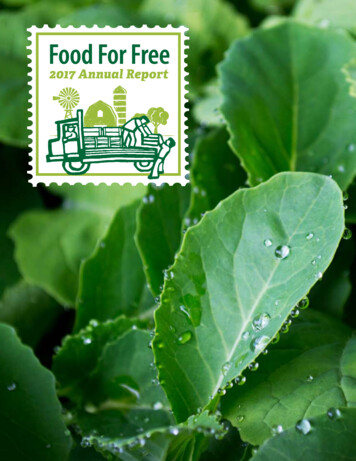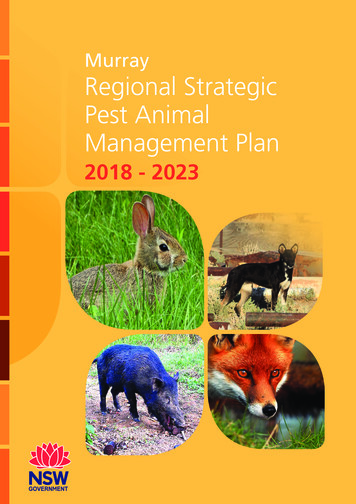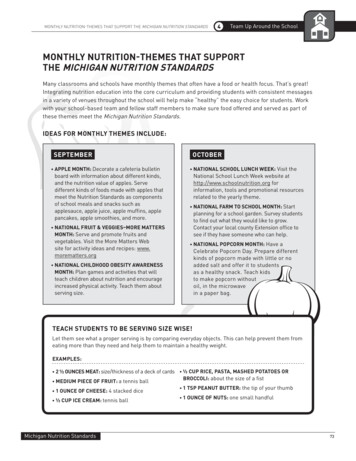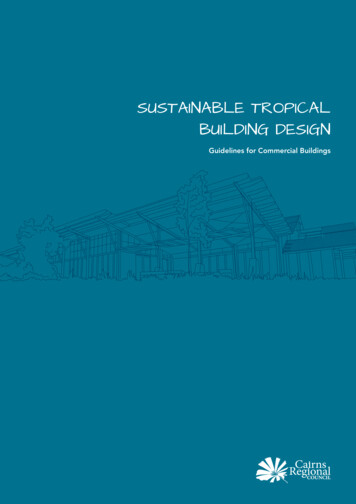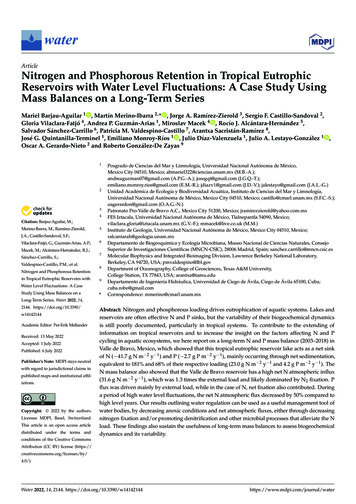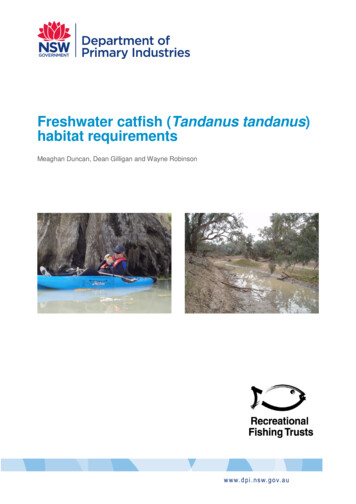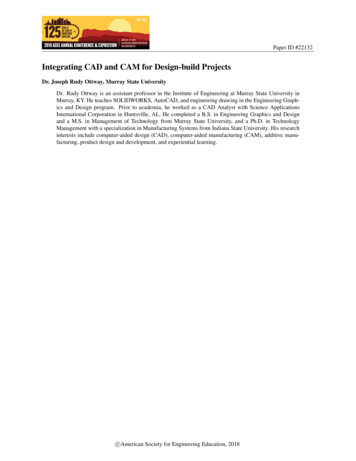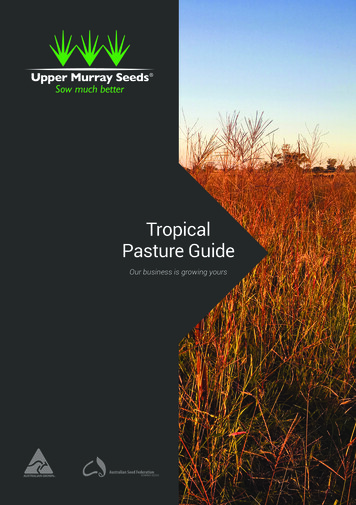
Transcription
TropicalPasture GuideOur business is growing yours
UMS Tropical Pasture GuideOur storyMeet Upper Murray SeedsUpper Murray Seeds is a growing Australianagribusiness built on solid foundations andsound values. We’re a privately-owned companyestablished in 1993 by Directors, Stewart andKate Sutherland, and we’ve been growing aroundthe country ever since.As a national wholesale business, UMS workshard to provide a professional and competitiveservice to rural resellers around Australia,however we place great value on the personalrelationships developed with our client base.We’ve built our reputation on providing the qualityseed products and solutions needed to booston-farm productivity for farmers located acrossAustralia.With branches in southern QLD and northernNSW, tropical pasture seed is a natural extensionof our product offering. Our experienced teamcan help you with advice and recommendationsto optimise product performance.Sow much better.Cover: Premier DigitPage 2: Rhodes GrassPage 3: Black Stallion Cow PeasDISCLAIMER: All information provided is intended as a guide only. Upper Murray Seeds has taken all due care to ensure the includedinformation is accurate and use of this information is at the user’s sole discretion and risk. Varying environmental conditions may alterthe performance of products and plants. The sowing rates provided are a guide only. You should refer to your agronomist or advisorfor sowing rates suited to your particular situation.
1st Edition, July 2020ContentsOur story 2Getting the best from tropical pasture4Your 8-step guide to success4-6Tropical grasses7-9Tropical legumes 10-11Forage sorghum 11www.uppermurrayseeds.com.au3
Getting the best from tropical pastureUpper Murray Seeds has a wide selection oftropical legume, grass and pasture speciesavailable to suit your specific conditions.This guide has been designed to assist youin finding the right pasture mix that best suitsyour land and livestock. When selecting seed, itis important to consider the objectives of yourenterprise, as well as factoring in: Soil test results Sowing methods Type of stock you’re running Grazing patterns Feed demand Local topography Rainfall patternsCustom mixing is also available on all seed types.Speak to your UMS Area Manager about the rightmix to optimise production in your local area.Green Panic Grass.Your 8-step guide to successPower your production with properpreparation, establishment andmanagement.Productive tropical pasture stands can beachieved by following a couple of key rules prior toand post-sowing seed. The following notes are aguide to the principles that have helped growers inmany districts develop their country thus leading toimproved pastures, better performing paddocks, allof which boosts their bottom line.Step 1. Paddock preparationThe initial focus for planting a tropical pasture is toselect the cleanest and most productive paddockthat may be suited to growing such species. Thereis no point in trying to grow the most expensivegrass on the wrong paddock. Implement a 2-3year cereal phase, this is aimed at reducing weedburdens using both chemical controls and highlycompetitive varieties of oats, barley or wheat.Black Stallion Cow Peas, Northern NSW.4
Herbicide control options within these key cerealvarieties provide the opportunity to control hardto kill weed species. Speak with your agronomistabout spray options to control grass weeds overprevious summer periods, as in some cases threesprays may be required to control varieties suchas Barnyard Grass.Weed competition is a major cause of tropicalpasture failure, so understanding the weed-burdenin intended paddocks is the key to controllingproblem weeds. Be careful with some chemicalwithholding periods, spraying too close to sowingcan injure tropical seedlings. Fallow the paddockand keep it weed free.Seek advice from your agronomist if necessary,however as a general guide, a mixed grass andlegume stand will provide improved pasturequality with good protein for growing animals.Step 4. Plant on good soil moistureAs a general rule (and if possible) always planton good soil moisture and with a rising soiltemperature of 16 degrees (always a goodidea to consult with your agronomist). Plan forgood rainfall four weeks following emergence toprovide growing moisture for the secondaryroot development of seedlings. Reducing weedcompetition can make better use of availablemoisture.Step 2. Soil health checkAs with any new enterprise it is imperative thatyou know what your soil nutrition levels are bytesting the soil. On previously cropped country thisis a very important factor due to crop nutritionaluse and residual fertiliser from previous years’operations. This step allows you to know whereyou are starting from.Soil testing informs you about what is required tobring nutrition up to an optimum level for growingtropical species. This critical preparatory stepallows adjustments to be made before you investin the seed and provides time for soil ameliorantsto take effect.Step 3. Tailor varieties to your areaTake a drive around your area, look at yourneighbour’s tropical paddocks and determinewhat is suited to the region – but bear in mindthat what works for one person does not meanthe variety will grow in your paddock. If in doubt,start with a small plot to see what will grow in yourpatch.It is imperative to check your soil nutrient levels.Your soil test should give an indication of thetexture and type of soil you have: eg heavy, light,sandy, clay or a mix of everything. Armed with thisinformation you can choose varieties suited bothto the area and soil type.5
Step 5. Use quality seed and treatmentAlways remember that if you plant good qualityseed there is a greater chance of stand success.This ‘rule of thumb’ also relates to coating seedwhich helps to protect seed from insect removaland wind disturbance. Coated seed has theadded benefit of ballistic capability – giving theseed weight to move through sowing equipmentwithout bridging or blocking up in sowing gear.Some tropical species are ‘feather-light’ andblow easily on the wind. As an effective insurancepolicy, we recommend UMS SupaCote seedtreatment to protect your investment in seed.The improved ballistic properties of SupaCote treated seed means it is suitable for aerial sowingfrom either helicopter or plane.Verano Stylothan 1cm deep or take the boots off existing drillequipment and lightly harrow/roll the seed in.Step 7. Grazing managementSupaCote helps protect seed from pests,improves germination and enhances plant growth.SupaCote is made up of Apron (a fungicide) andGaucho (an insecticide) which are encapsulatedwith a protective layer. Ask your agronomist orUMS Area Manager for more information.Step 6. Planting depthTropical grass species are sensitive to sowingdepth and nearly all failures occur due to thisfactor. Most existing sowing equipment is set upfor the sowing depth that suits oats or barley andwill need to be recalibrated or modified to suit thetropical seed size and planting method.Sowing too deep usually results in poorestablishment. Aim to plant varieties at lessTropical species should be fully anchored bymature root systems before they are grazed.Young plants should only be grazed lightly toencourage tillering, ie stimulating growth withoutdestroying the growing points of grasses.In their first year, the newly sown paddocksshould be rested and allowed to set seed to aid inregeneration. Hay production is notrecommended in first year as this tends to reducestand density.Step 8. Topdressing with fertiliserIt is generally recommended to topdresstropical pastures with nitrogen-basedfertiliser following grazing because nutrients willhave been transported to other paddocks, or offfarm, in the form of meat produced. Always aimto replace and build on what nutrients have beenused within plant and animal production systems.6
Tropical grasses LEGENDPoor Fair CharacteristicsVarietyRainfallSoil Type3-15 kg/ha600mmLight/MediumFrostWaterlogging 4-10 kg/ha800mmLight/Heavy Biloela BuffelHardy and productive subtropicalgrass widely used in northernAustralia. Utilised in friable claysoil types.4-15 kg/ha300mmMedium/Heavy Gayndah/USA BuffelHardy and productive subtropicalgrass widely used in northernAustralia.4-15 kg/ha300mmLight/Medium 3-15 kg/ha600mmLight/Heavy 4-15 ANTHIUMFloren BluegrassCan be established in crackingclay soil types. Good performerin summer rainfall areas. Alsotolerant of drought, flood and mildsalt.DIGITARIAPremier DigitHardy, productive, tufted perennialgrass that establishes well in sandyloams to medium clays. Well suitedto inland regions of QLD and northwestern NSW.Very GoodDroughtBLUEGRASSSignal GrassLeafy, perennial grass for highrainfall regions in northernAustralia. Responds well tonitrogen, making Signal Grass idealfor beef cattle finishing. TolerancesSowing RateBisset BluegrassHardy with good drought andgrazing tolerance. Creeping inhabit. A widely used pasturespecies.Good 7
Tropical grassesCharacteristicsVarietyTolerancesSowing RateRainfallSoil Type4-15 kg/ha350mmLight BambatsiGenerally used in beef grazingsystems in sub-tropics. Suitedto fertile, medium to light claysoil types. Erect in habit, it is anexcellent companion to pasturelegumes.3-15 kg/ha500mmMedium/Heavy Gatton/GreenGenerally used in beef grazingsystems in sub-tropics. Suitedto sand, loam and medium tolight clay soils. Erect in habit, it isan excellent companion to otherpasture grasses and legumes.Green Panic has good shadetolerance.3-15 kg/ha650mmMedium/LightPaspalum dilatatumGrazing-tolerant perennial grassused in grazing systems. Suited tofertile alluvial soils in high rainfallsub-tropical regions.3-10 kg/ha750mmMedium/LightWettsteniniiGrazing-tolerant perennial grassused in grazing systems. Suited tofertile alluvial soils in high rainfallsub-tropical regions.4-7 kg/ha800mmMedium/Light5-20 kg/ha650mmLight/MediumLOVE GRASSConsolPersistent, perennial grass for lightsandy soils. Used as a binder inrevegetation. Not highly soughtafter by stock.PANIC GRASSPASPALUMRHODES GRASSCallideUsed in fertile, high rainfallenvironments. It is a productivetetraploid pasture species suitedto warmer northern climates.Moderately tolerant to salt.DroughtFrostWaterlogging 8
Tropical grassesCharacteristicsVarietyTolerancesSowing RateRainfallSoil TypeDroughtFrostWaterlogging2-20 kg/ha650mmLight/Medium Narok/Solander/SplendaHardy perennials suited to coastalregions. Can withstand coldconditions and light frosts. Mostlyused in beef grazing systems.3-15 kg/ha800mmMedium Purple PigeonSummer-growing perennial grasswith good drought tolerance. Wellsuited to inland brigalow soil typesof western QLD and north westernNSW.4-15 kg/ha600mmHeavy3-15 kg/ha500mmLight/HeavyRHODES GRASSKatamboraA fast-establishing, stoloniferousperennial pasture species withmoderate salt tolerance. It is usedwidely in grazing systems and hayproduction and is also suitable forsoil erosion control.SETARIAUROCHLOASabi GrassTussocking low summer-growingperennial grass utilised in beefgrazing systems in tropicalenvironments. 9
Tropical legumesCharacteristicsVarietyTolerancesSowing RateRainfallSoil TypeDroughtFrostWaterloggingAztec AtroHighly palatable, summer-activetwining legume suitable forgrazing, hay and silage in warmclimates with high rainfall.2-6 kg/ha650mmLight/Heavy Butterfly PeaSemi-twining, summer-activelegume suitable for grazing inwarm climates.4-10 kg/ha550mmMedium/Heavy Burgundy BeanHighly palatable, summer-active,twining legume suitable forgrazing, hay and silage with goodcold weather drought tolerance.3-5 kg/ha400mmLight/Heavy Marc DesmanthusSummer-active perennial legumewith good drought tolerance.Well suited to inland brigalow soiltypes of western QLD and northwestern NSW.2-5 kg/ha500mmMedium/Heavy Seca StyloErect perennial legume, shrubbyin appearance. Can persist underintense grazing conditions.Grows well in lighter, acidic,sandy soils.2-6 kg/ha500mmLight Verano StyloPersistent, erect summergrowing legume, shrubby inappearance. Well adapted totropics and warmer regions of thesub-tropics.3-7 kg/ha600mmLight Wynn CassiaProstrate to semi-erect, shortlived summer growing legume.High seed set and it is selfregenerating.2-5 kg/ha625mmMedium/Light PERENNIAL LEGUMES10
Tropical legumesCharacteristicsVarietyTolerancesSowing RateRainfallSoil TypeDroughtFrostWaterloggingRongai Lab LabFast growing very late maturingannual/biannual summer foragelegume. Also suitable for silageand green manure break crops.10-50 kg/ha600mmLight/Medium Highworth Lab LabFast growing late maturingannual/biannual summer foragelegume. Highworth Lab Lab is anearlier maturing option to RongaiLab Lab. Highworth is also usedin silage and green manure breakcrops.10-50 kg/ha600mmLight/Medium Buff/Red Caloona/Ebony/Black Stallion Cow PeasFast growing twining annuallegume. Use as summer forage,hay, silage or in green manurecrops. Well suited to areas withsummer rainfall. Cow Peasimprove soil fertility thoughnitrogen fixation.10-40 kg/ha600mmLight/Medium ANNUAL LEGUMESForage sorghumCharacteristicsVarietyTolerancesSowing RateRainfallSoil TypeDroughtFrostWaterlogging1-10 kg/ha500mmLight/Heavy FORAGE SORGHUMSilk SorghumFast growing tussockingperennial. Mostly used incattle production systems asa component in short termperennial pasture blends. Canalso be used as cover for slowerestablishing perennial grasses.11
UMS WarehousesQueenslandCall 0429 459 920DarwinNorthern NSWCall 0427 034 119North Coast NSWCall 0438 590 uryMelbourneCorryongWACall 0429 484 497SA/Southern VICCall 0428 406 464Northern VICCall 0427 406 464LauncestonHobartSouthern NSWCall 0439 484 403TasmaniaCall 0437 076 920Head OfficeTel (02) 6040 6464, Fax (02) 6040 64701014A Nowra Street, Albury NSW 2640Email .com.auCurrent July 2020
Gaucho (an insecticide) which are encapsulated with a protective layer. Ask your agronomist or UMS Area Manager for more information. Step 6. Planting depth Tropical grass species are sensitive to sowing depth and nearly all failures occur due to this factor. Most existing sowing equipment is set up for the sowing depth that suits oats or .


